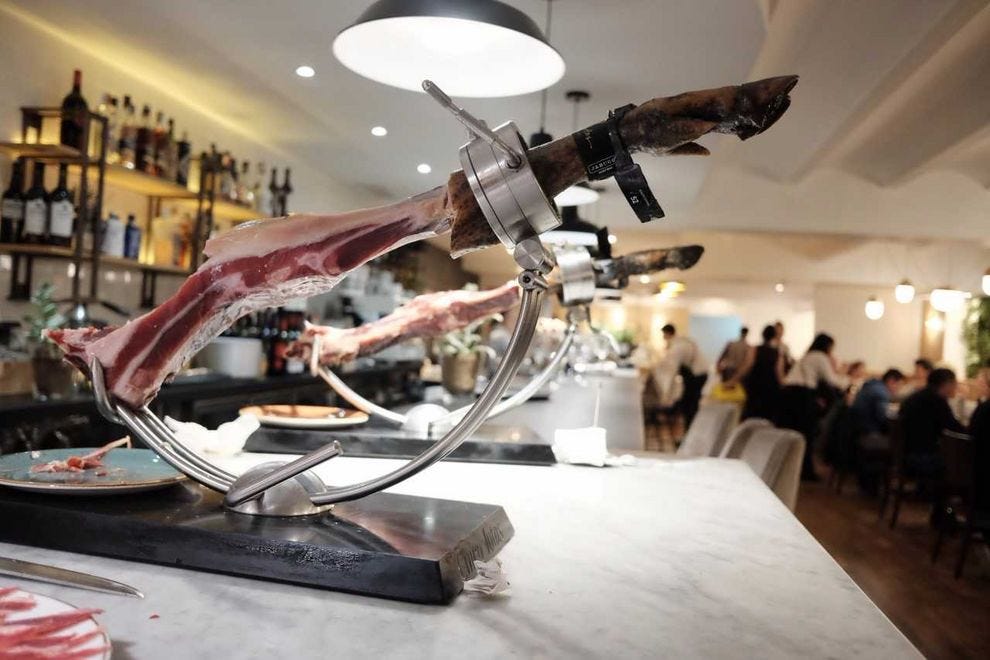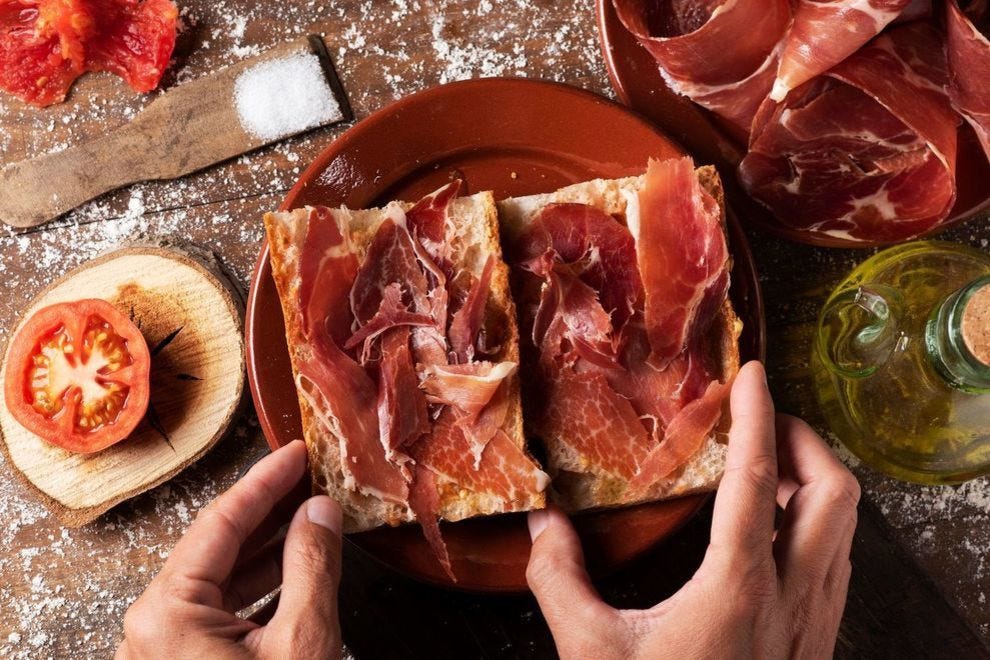Products You May Like
When you walk into Cinco Jotas in Spain, the first thing you see is a pig leg, tan and crimson, sitting on the front counter. It’s suspended on a carving stand, with its black hoof pointed away from the carver, who uses a long, thin knife to slice the meat.
Slicing jamón (Spain’s beloved ham) is no joke; it’s a rigorous process and is reserved only for the truly skilled. The jamón carver at Cinco Jotas was intensely focused, her eyes never leaving the leg of meat before her. She sliced 2-inch cuts with the swiftness of a ninja – fast and thin and uniform in size. She’d whip out a plate of meat in a matter of minutes, then move on to the next order.
I was mesmerized by her capabilities, and needed to try what she was serving for myself. Sitting at a table for one, I ordered a veritable feast: 25 shrimp laying on a bed of salt, triangles of Pajarete Gran Reserva cheese, typical Catalan toasted bread topped with a light tomato paste and olive oil, a dish of garlicky olives and nuts and, of course, ham.
 The world of jamon is vast and nuanced — Photo courtesy of Katka Lapelosova
The world of jamon is vast and nuanced — Photo courtesy of Katka Lapelosova
In America, cured pork products are relatively limited. You can usually find prosciutto to go along with your cheese board, but Spain is a culinary fantasy land for lovers of cured meat; jamón is everywhere and comes in innumerable forms. Walk down any street in Barcelona and you’ll find pig legs hanging in the window, ripe for the slicing, and sausage parties any night of the week.
Up until recently, tourists could even attend the Jamón Experience, which may have been an informative introduction to the meat, but felt like a Disney-fied display of pork.
Cinco Jotas – arguably the most famous of all jamón producers and one that’s been around for over 140 years – has an entirely separate menu for jamón, seven choices with prices ranging from around €9 for a half portion to €25 for a full portion. I settled on a €13 half portion of caña de lomo natural.
So what makes Jamón Ibérico so special and expensive? Which parts of the pig are the best? Which are the least coveted? Here’s a breakdown of the seven items on Cinco Jotas’ carving menu to get a better idea of what you’re ordering when you go to Spain.
Jamón ibérico
With bread is one of the many ways to enjoy slices of jamon — Photo courtesy of iStock / nito100
This is the most revered, most complicated and most expensive variety of Spanish ham, but not all jamón ibéricos are equal.
Iberian pigs come from a small, southern region in Spain. They’re black in color, they produce smaller litters and don’t have as much meat as other pigs. They’re also completely free-range, and their diet ideally consists of bellota, Spanish acorns that are responsible for making the pigs’ fat creamy and soft, as well as giving the ham a nutty flavor.
That’s why jamón ibérico bellota is more expensive than jamón ibérico de recebo (pigs that eat both acorns and cereals), jamón ibérico cebo de campo (pigs that are fed only cereals) or jamón ibérico de cebo (pigs that only eat cereals and are not free-range, like the other types of the famous ham).
The aging process takes anywhere from a year and a half to more than three years in a naturally climate-controlled cellar, and involves a “sniff test” before exporting. The delicate nature and intricate bone system of this pig requires the ham to only be cut by hand.
The meat is best served at room temperature. It should be thinly sliced, contain a good amount of marbled fat, be bright red in color and melt in your mouth. Combine the process of raising pigs, curing the meat and finding ham cutters worthy of their post, and you’ve got yourself an expensive product.
Paleta
 The meat from the front of the legs is much thinner than the back legs — Photo courtesy of Katka Lapelosova
The meat from the front of the legs is much thinner than the back legs — Photo courtesy of Katka Lapelosova
This is meat that comes from the front legs of the pig, as opposed to the rear legs, which is where the jamón iberico comes from. Its flavor is more intense than typical jamón, due to the bones and muscles being thinner, which allows it to be cured for less time.
It’s a less expensive option if you’re on a budget, and it comes from the same animal, so you’re still getting a quality product.
Caña de lomo
This cut comes from the loin of the pig – the long, cylindrical piece on the right side of the body. It’s pretty versatile in how it can be used, and is most widely made into loin sausage.
When served as-is, it’s just a lean cut with good marbling, and is often encased in a natural skin. Most times it is marinated with salt, paprika and garlic. It’s incredibly savory and flavorful due to the marinade, and is also good to eat with other tapas as it’s not as delicate as the other cuts.
Caña de presa
Cut from the shoulder of the pig, this meat is juicer than other pieces due to its high fat content. You can definitely eat it cured, but Cinco Jotas recommends serving it grilled to “preserve its juiciness and allow the infiltrated healthy fats to deliciously melt in your mouth.” Or you can roast it, “since its flavor is enhanced after a prolonged cooking process.”
Chorizo

Jamón ibérico is the most famous cut of meat in Barcelona, but chorizo is probably the most popular. Because it’s a sausage, it’s one of the cheapest sliced meats you can get. Don’t let the price fool you though; it’s still better than nearly anything you’d get outside of Spain.
Morcón chorizo
Morcón chorizo is quite unique, as it’s made from the large intestine. So, there is more meat to be had, and it’s thicker than regular sausage. Chorizo on its own is bright red in color (from paprika) and can be slightly spicier than other cuts. You’re also more likely to find this kind of meat mixed in with other Catalan dishes, such as paella.
Salchichón
Another larger-than-usual sausage, salchichón is dry-aged and consists of leaner pork, and pieces of back fat. It’s most similar to traditional salami, so it’s a little firm (despite being cut thinly), a little greasy and a little herby in taste.
It’s an inexpensive option, and the best kind will include pieces of Iberian pig, so you’ll still taste that acorn-y flavor for which jamón ibérico is famous.

